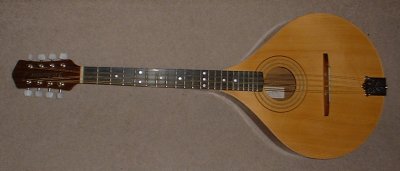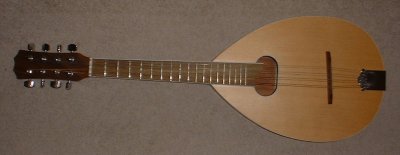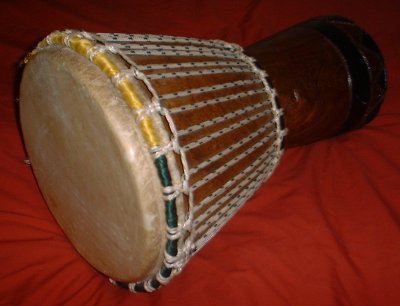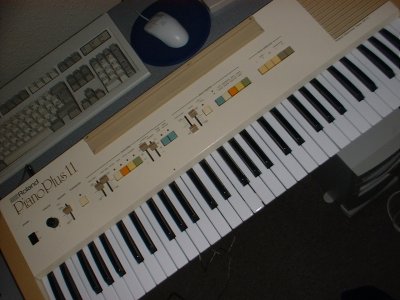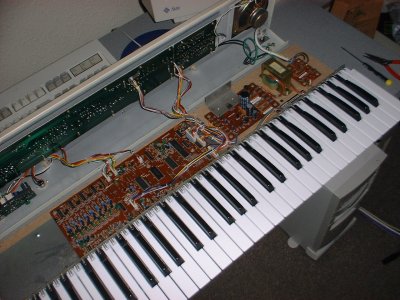Like many musicians, I have too many instruments, most of which I play very badly. Here are some of them.
Contents
Mandolin-family instruments
Freshwater octave mandola
This is my main instrument. Bought second-hand from Hobgoblin in 2004; made by Freshwater Instruments for Soar Valley Music, according to the label. (Freshwater Instruments ceased trading in 2011.)
Its previous owner clearly got a lot of use out of it; the finish is rather beaten-up, but it's a very playable instrument with a good feel to the neck, and I've been really happy with how it sounds. It's very solidly-built — the top is 3-4mm thick, and it's noticeably heavier than the bouzouki despite the shorter scale length.
In 2012 I had a Skyinbow Pure Acoustic pickup fitted to the bridge, along with a tailpin jack. This works pretty well through a PA — and I like the battery-less preamp design.
Standard tuning: GGDDAAEE, a fourth below the mandola, and an octave below the mandolin, hence the name.
Williams GZ3 guitar-bouzouki
Bought from Phil Williams. The idea here is to take a reasonably decent Asian guitar design, and modify the headstock, nut and bridge for eight strings rather than six.
This is a good plan, but some setup was required to make it play well. The factory apparently got the string spacing wrong at the bridge for the first batch of GZ3s, so mine had had the bridgeplate replaced, and the brand new bridge fitted was much too tall. Having filed the bridge down by about 1.5mm and adjusted the truss rod to match, it now has reasonable action.
I've tried this tuned several different ways — currently I've got it set up as a regular Irish bouzouki, GGDDAADD with octave strings on the lowest two courses, but it also works with unison strings — or with just four strings on, as a tenor guitar.
Leedy Collegian tenor banjo
This was built by the Leedy Drum Company in Indianapolis, mostly likely in 1929 or 1930. I bought it from Hobgoblin in 2012, rather dirty but in playable condition, and with the original case. It's unusual in that the pot and resonator are solid steel — which makes it rather heavy to carry, but it's got excellent sustain, and you can get a nice variation of tones from it with and without the resonator.
I completely dismantled it and spent a happy couple of weekends (and most of a tube of metal polish) cleaning it up. I also fitted a new head to replace the cracked one it came with, and a new set of GDAE strings; it now looks very smart and plays well. (For anyone else who's got a Leedy Collegian and isn't sure where to measure: it needs an 11" high crown head. Mine's a Remo BJ-1100-H2.)
Two things still need sorting out: the adjustable bridge fitted isn't the right kind (and doesn't fit properly in the case), and it has some shims fitted to get the neck angle right, which only sort of work.
Adam Black S-5CE acoustic guitar
Bought second-hand from Will in 2006, after resisting the temptation to buy a guitar for many years. This is the instrument I normally use when playing live, since it's got a Fishman Classic piezo pickup and EQ installed. It sounds great with really heavy strings, but for the sake of my fingers it's usually got a Martin .011-.052 (purple) set on it.
This is usually in standard tuning, with occasional forays into DADGAD or drop-D.
Ibanez V302 12-string
Bought second-hand from Dave in 2009; this was built in 1980. This is a very large and heavy instrument — not really practical to play live, especially given that it has no strap buckle — but it does sound nice. The nut is currently falling apart.
When I got this instrument, it was tuned a semitone below standard tuning to reduce finger-shredding effects. Some cautious truss rod adjustment has brought the action back down to a sensible level, so it's now back in standard tuning.
Ibanez GAX30-TR electric guitar
Bought new from Thomann in 2007. Having played a few friends' guitars, I wanted something that had a decent neck and a fixed bridge (since cheap tremolos tend to be more trouble than they're worth) — this guitar fit the bill. It's got the stock humbucker pickups, which do indeed reject hum pretty well, but need some treble boost to sound reasonable. I'm using Ernie Ball .011-.048 strings.
I usually play this through a solid-state amp that I built into a old toolcase, which has a Fuzz Face-ish distortion effect built in; I normally use a BBD delay line (a modified CB echo effect box) too. I do have some fancier multieffects, but they don't get used very much...
Standard tuning, I'm afraid.
Fender 013-6208-575 Fretless Jazz Bass
Bought new in 1998, this bass guitar was built by Fender in Corona, Mexico; the colour's "Midnight Wine", the body's alder, the neck's maple, and the fingerboard's rosewood.
Fretless bass guitar seemed the natural next step after playing double bass at school; I wanted a more portable instrument, and I was already used to playing a fretless instrument. This is a really nice instrument — much better than my skill at playing it justifies...
It's tuned EADG, the same as a double bass.
You can listen to a clip of me playing the bass without any effects (an overdub for a multitrack recording I was doing), or a clip of me playing with one of the sillier effects on a Boss DSP stompbox.
Mahalo ukulele
Cheap and cheerful ukulele, of the type that £20 will buy you at most music shops. This has friction pegs, so it doesn't stay in tune very well (although fitting a set of decent strings helped a lot); if you're looking to buy a ukulele I'd suggest spending a bit more to get one with real tuning machines. (I now have some proper tuners rescued from a broken uke that I need to retrofit to this at some point...)
It's fun to play, though — nylon strings make ludicrous bends really easy!
Tuned gCEA (the standard "my dog has fleas" reentrant tuning for ukes).
Flatback mandola
Bought new in 2003 from Socodi (since closed) in Canterbury, this is a simple made-in-China flatback mandola. It now lives in my office...
It's well-built and sounds OK for the price. Two minor problems: it doesn't play in tune very well up the fingerboard (no matter where the non-compensated bridge is positioned), and it drifts out of tune fairly quickly when played with a pick.
Standard tuning: CCGGDDAA, a fifth below the mandolin.
You can listen to a clip of me playing this mandola, recorded using a tie-clip microphone as a contact pickup; the recording was multitracked with both parts played on the same instrument.
Percussion
Djembe
This is a pretty typical small djembe, about 45 cm tall. The body's carved from a single large piece of wood, smoothed and varnished on the outside but roughly-textured on the inside. The wood's got a distinctive (pleasant) smell. It's quite heavy, so when I'm playing it gripped between my knees I need to be careful not to drop it on my foot.
This is a very loud instrument — as you'd probably expect for a hand drum. It's great fun to play, but lack of acoustic insulation means I don't get the opportunity very often. You can get a surprising variety of noises from it by playing in different ways: as well as the usual tom-tom sound that just hitting the skin gives you, you can get sharp snare-like noises by tapping the rim, muffled bass thuds by muting it with one hand and playing with the other, loud scratches by running your nails across the skin, quiet taps by hitting the body, and even talking-drum-style sounds by playing it upside down and making it resonate by drumming across the open bottom.
It's not really a tuned instrument, but my chromatic tuner claims that it resonates at a rather sharp A, which you can bend down to F or so by partly covering the bottom.
Here's a clip of me playing a not-terribly-exciting drum part on the djembe.
Mini-djembe
OK, so perhaps the djembe above isn't so small: this one's about 15cm tall. It's clearly a novelty, but it's actually playable.
Synthesisers
I grew up playing my parents' piano, but I don't own one myself. I've done quite a bit of music with trackers and sequencers, but these days I prefer to play parts in real time and edit in the audio domain.
StudioLogic SL-990 Pro
This is an 88-key full-size weighted MIDI controller keyboard — I got a good deal on it by buying it just after it had been discontinued in favour of a newer model with more controller inputs. It's got just about the bare minimum of features to be useful as a controller keyboard: 88 keys (slightly larger than most pianos I've played), pitchbend and mod wheels, a sustain pedal input (it didn't come with one, but since it's just a switch contact I use an old pedal I've had around for ages), buttons for programme change and bank select, and another to select the touch-sensitivity response curve. It's nailed to MIDI channel 1, unfortunately, so I need a PC in the way if I want to play more than one synth module with it.
The feel is very good — it's clearly not a real piano mechanism (there's no "snapback" after a key is pressed), but the keys respond to very small amounts of force and are appropriately-weighted to behave like a real piano when it's being played. The mechanism is quite noisy, but I suspect that's difficult to avoid.
Roland D-110
This is a 1U MIDI synth module dating from the early 90s; it's based on Roland's LA synthesis algorithm (which is similar to Yamaha's FM synthesis: you pick oscillators and formulae to combine them). The built-in sounds are unremarkable, but you can use SysEx to dump new instrument sets to it; there are some decent electric piano, chromatic percussion and drum sounds available. It predates GM, but Roland provide a downloadable (awful) GM instrument set for it.
One neat feature is that it's got eight separate outputs, and you can assign channels (and, with some limitations, parts of patches) to different outputs — so this would make a great trigger source to control a load of external gates, if I wanted to do that. It's mostly so that I've got something to play with the SL-990 if I'm away from a computer, although I do sometimes use it for drum sounds.
Boss DS-330
A keyboard-top MIDI synth module, acquired from Freecycle.
As usual, the best sounds are those that aren't trying to sound like a real instrument; it's got some really nice synth leads, pads and organs, and a splendidly 80s "choir oohs". Nobody is going to be fooled by its piano sounds, though...
Roland EP-11
This is a low-end "electronic piano" keyboard dating from the early 1980s. It's got a full-size keyboard and produces a variety of different harpsichord-like noises; five buttons select different sets of harmonics, and a slider (labelled "Sustain") controls the envelope decay rate. I think it's 8-note polyphonic. It's also got a pretty standard auto-accompaniment system, a pitch control on the back so you can tune it to other instruments, and a sustain pedal input. Unusually, it's got a transpose button, so it's really easy to play in awkward keys.
I've had to straighten the copper bar that's used as a ground contact along the length of the keyboard a couple of times, and glue one of the keys back together after the bit of plastic that the spring attaches to broke off.
While the keyboard's unweighted, the feel's quite good, and it doesn't sound too bad through an amplifier if you mash several of the "tone" buttons down at the same time. Nobody's ever going to mistake it for a real instrument, though!
You can listen to a clip of me playing the EP-11, with no intervening effects or amplifier so it sounds even worse than it does through the built-in speaker.
Miscellaneous
Harmonicas
I don't really do wind instruments, but I've got into playing harmonicas recently. I've had Hohner Blues Harp MS diatonics in C, G and D for a while, but have had more luck lately with other tunings. The instruments I play most often are a Suzuki SU-21 tremelo in A, and a Seydel Blues Session in A circular tuning (which gives you a D scale); both of these work nicely for trad music.
